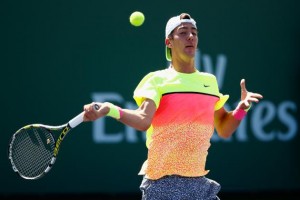by Andrew Eichenholz
Thanasi Kokkinakis is one of the future stars of the ATP World Tour, and he showed his mental fortitude in beating former top-10 player Juan Monaco in a third set tiebreaker to reach the Round of 16 at Indian Wells.
The thing is, the match was over way before that. The young Australian served for the tense matchup at 5-4 in the third set after a long battle full of physical baseline rallies.
Monaco hit a ball give or take a centimeter wide on the singles line closest to the chair umpire, Mohamed Lahyani, yet no call came from either him or the linesman. Instead of game, set, match, Kokkinakis, it was play on.
It did not have to be if the 18-year old had a challenge, which would have enabled him to use the Hawk-Eye system in place on every court at Indian Wells. He had used all three—the number that players are allowed per set—and was rendered helpless.
While fans, media and everyone following along were stunned, the duo continued on, with Monaco playing looser tennis that he seemingly plucked from the depths of his new-found life. Perhaps more impressive was the resolve of his opponent.
Kokkinakis found himself down 5-6, serving to stay in it, in a position where Andy Roddick would have launched every ball on the court into the nearby desert, and John McEnroe quite possibly would have stormed off.
On a hot Monday evening, he gathered himself and won the match. There were no “ifs” to discuss, as he refused to lose, pounding his heart after the victory. A couple of bad calls may have been thrown his way, but yearning for a win was more important than getting upset.
That does not take away from the fact that a shot here and there, and the challenge system very well could have taken a hard-fought win away from Kokkinakis. Forget that, but with the cut-off for main draw entry into the French Open creeping up, the youngster was running out of time to earn enough ranking points to avoid the cauldron that is competing in Grand Slam qualifiers.
It became irrelevant in this match, but in the case of a set ending in a tiebreaker, each player receives one additional challenge. That means that the maximum number of times that a competitor could challenge a call in one set is four. So, if they exceed that limit by unsuccessfully using the system four times, they are out of luck.
For all intents and purposes, at the U.S. Open where affairs are capped on both the men’s and women’s side with a tiebreaker, someone can lose their shot at Grand Slam glory because they cannot challenge.
Roger Federer, who has 17 Grand Slam titles under his belt, could be on the brink of an 18th championship, five hours into a major final on Arthur Ashe Stadium. On match point for his opponent, Federer can hit a winner that is called out by the linesperson, without overrule by the chair umpire.
If Switzerland’s own does not have any challenges, he would be out of luck. Deep in a fifth set, one match point lost can be the difference. Just imagine that.
So how can the world of tennis account for such possibilities?
Many would argue that if a player misses on three challenges, that they do not deserve the chance for another, and should have minded their previous questioning.
But, at the end of the day, it is not fair to affect the outcome of a massive tournament on a matter of principle. That is not good for the players, or the sport.
There are various options that could be looked at. One would be to grant players unlimited challenges in order to make sure that every call on the court is correct, but that is somewhat detrimental. There are too many players who misuse the challenge system already, that doing so would enable players to even possibly stall play by throwing away a challenge for the sake of taking a breath.
Another option would be to give the chair umpire the prerogative to challenge a call made by a member of his crew, once the players are out of their allotment. That still does not guarantee fairness, as an umpire may choose to question a decision for one player while not his or her opponent.
Finally, channeling the National Football League and the National Basketball Association along with other major sports leagues would be automatic replay on close calls toward the end of a match. Whether it be deciding to do so in tiebreakers, deciding sets, on break points, or all of those, it would inhibit the ability of a linesperson’s bad call to influence a match.
There are many options out there, but there is one thing that is not an option: not using capable technology to its fullest ability.

